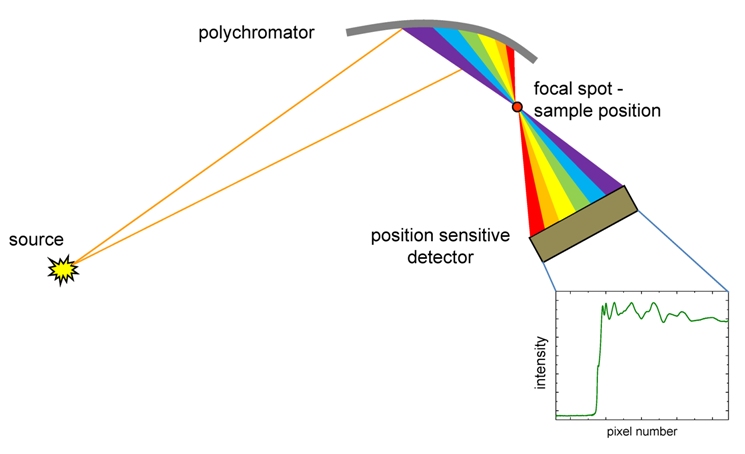Energy Dispersive EXAFS
The principle of the Energy Dispersive EXAFS (EDE) is based on the diffraction of non monochromatic X-rays by a bent crystal (polychromator crystal). The polychromatic beam is focused on the sample and then diverges towards a position sensitive detector where beam position is correlated to energy. The dispersive configuration of XAS has two main advantages that make it scientifically attractive. First, the whole x-ray absorption spectrum is collected simultaneously which makes the technique especially useful for the study of fast processes. Second, the size of the focussed beam at the sample position is small and very stable due to the fact that no movement of optical elements is required to collect the spectral data.

Some examples of science where this technique plays an important role are listed below.
i. Chemistry.
The study of catalysts under their operating conditions is a particular challenge as they are often present in low concentration and suffer rapid structural transformation under rapidly changing environmental conditions, such as temperature of the reaction, or composition and flow rates of gasses. [1] The possibility of follow reaction processes from the atomic viewpoint on second and millisecond time scales opens unique possibilities for the study of heterogeneous and homogeneous catalysis [2]. The high flux of I20 will further enhance our capabilities for time resolved chemistry by extending the time resolution of this technique to the micro-second range and such developments now raise many tantalising possibilities in for example, the study of photochemical processes.
ii. Material science.
The small focal spot at the sample position is ideally suited to the study of samples under extreme conditions of high pressures and temperatures where the use of small volumes is often unavoidable e.g. in diamond anvil cells. [3] Another technological area that will benefit from the time resolved capabilities and small focal size of an energy dispersive spectrometer is the study of kinetic processes in operating electrochemical cells. [4] In these systems spatially resolved investigations are often essential as the physico-chemical mechanisms of interest to the technologist often depend on proximity to an electrode.
iii. Environmental science.
The study of the development and properties of amorphous phases in the first few milliseconds after precipitation can provide key information in the study of processes used for the disposal of toxic materials. Such phases often predominate in many surface environments and are a major suspended constituent of discharges from waste disposal sites. The time-resolved capabilities of the I20 dispersive spectrometer would be ideally suited to such investigations.


 Spectroscopy
Spectroscopy
